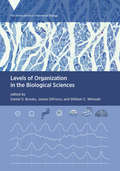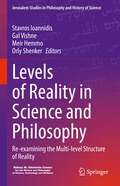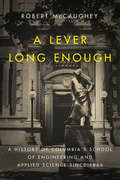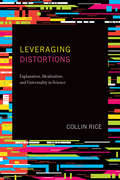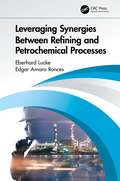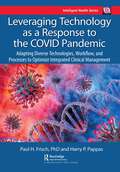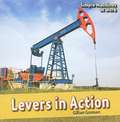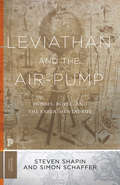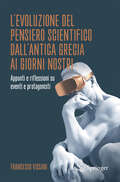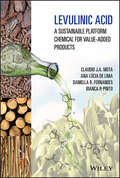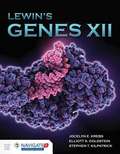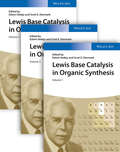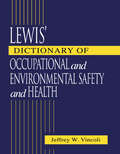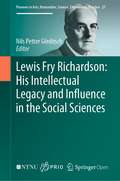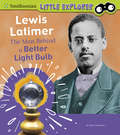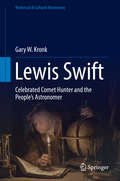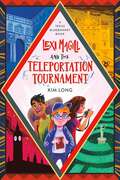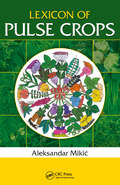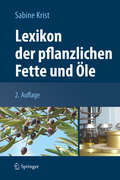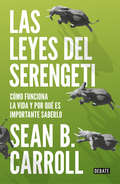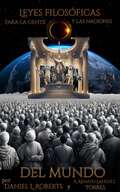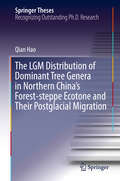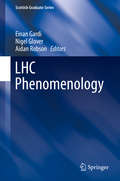- Table View
- List View
Levels of Organization in the Biological Sciences (Vienna Series in Theoretical Biology)
by Daniel S. Brooks, James DiFrisco, and William C. WimsattScientific philosophers examine the nature and significance of levels of organization, a core structural principle in the biological sciences.This volume examines the idea of levels of organization as a distinct object of investigation, considering its merits as a core organizational principle for the scientific image of the natural world. It approaches levels of organization--roughly, the idea that the natural world is segregated into part-whole relationships of increasing spatiotemporal scale and complexity--in terms of its roles in scientific reasoning as a dynamic, open-ended idea capable of performing multiple overlapping functions in distinct empirical settings.The contributors--scientific philosophers with longstanding ties to the biological sciences--discuss topics including the philosophical and scientific contexts for an inquiry into levels; whether the concept can actually deliver on its organizational promises; the role of levels in the development and evolution of complex systems; conditional independence and downward causation; and the extension of the concept into the sociocultural realm. Taken together, the contributions embrace the diverse usages of the term as aspects of the big picture of levels of organization.ContributorsJan Baedke, Robert W. Batterman, Daniel S. Brooks, James DiFrisco, Markus I. Eronen, Carl Gillett, Sara Green, James Griesemer, Alan C. Love, Angela Potochnik, Thomas Reydon, Ilya Tëmkin, Jon Umerez, William C. Wimsatt, James Woodward
Levels of Reality in Science and Philosophy: Re-examining the Multi-level Structure of Reality (Jerusalem Studies in Philosophy and History of Science)
by Stavros Ioannidis Gal Vishne Meir Hemmo Orly ShenkerThis book offers a unique perspective on one of the deepest questions about the world we live in: is reality multi-leveled, or can everything be reduced to some fundamental ‘flat’ level? This deep philosophical issue has widespread implications in philosophy, since it is fundamental to how we understand the world and the basic entities in it. Both the notion of ‘levels’ within science and their ontological implications are issues that are underexplored in the philosophical literature. The volume reconsiders the view that reality contains many levels and opens new ways to understand the ontological status of the special sciences. The book focuses on major open questions that arise at the foundations of cognitive science, cognitive psychology, brain science and other special sciences, in particular with respect to the physical foundations of these sciences. For example: Is the mental computational? Do brains compute? How can the special sciences be autonomous from physics, grounded in, or based on, physics and at the same time irreducible to physics? The book is an important read for scientists and philosophers alike. It is of interest to philosophers of science, philosophers of mind and biology interested in the notion of levels, but also to psychologists, cognitive scientists and neuroscientists investigating such issues as the precise relation of the mental to the underlying neural structures and the appropriate approach to study it.
A Lever Long Enough: A History of Columbia's School of Engineering and Applied Science Since 1864 (Columbiana)
by Robert McCaugheyIn this comprehensive social history of Columbia University's School of Engineering and Applied Science (SEAS), Robert McCaughey combines archival research with oral testimony and contemporary interviews to build a critical and celebratory portrait of one of the oldest engineering schools in the United States. McCaughey follows the evolving, occasionally rocky, and now integrated relationship between SEAS's engineers and the rest of the Columbia University student body, faculty, and administration. He also revisits the interaction between the SEAS staff and the inhabitants and institutions of the City of New York, where the school has resided since its founding in 1864. McCaughey compares the historical struggles and achievements of the school's engineers with their present-day battles and accomplishments, and he contrasts their teaching and research approaches with those of their peers at other free-standing and Ivy League engineering schools. What begins as a localized history of a school striving to define itself within a university known for its strengths in the humanities and the social sciences becomes a wider story of the transformation of the applied sciences into a critical component of American technology and education.
Leveraging Distortions: Explanation, Idealization, and Universality in Science
by Collin RiceAn examination of how scientists deliberately and justifiably use pervasive distortions of relevant features to explain and understand natural phenomena.A fundamental rule of logic is that in order for an argument to provide good reasons for its conclusion, the premises of the argument must be true. In this book, Collin Rice shows how the practice of science repeatedly, pervasively, and deliberately violates this principle. Rice argues that scientists strategically use distortions that misrepresent relevant features of natural phenomena in order to explain and understand--and that they use these distortions deliberately and justifiably in order to discover truths that would be otherwise inaccessible. Countering the standard emphasis on causation, accurate representation, and decomposition of science into its accurate and inaccurate parts, Rice shows that science's epistemic achievements can still be factive despite their being produced through the use of holistically distorted scientific representations. Indeed, he argues, this distortion is one of the most widely employed and fruitful tools used in scientific theorizing. Marshalling a range of case studies, Rice contends that many explanations in science are noncausal, and he presents an alternate view of explanation that captures the variety of noncausal explanations found across the sciences. He proposes an alternative holistic distortion view of idealized models, connecting it to physicists' concept of a universality class; shows how universality classes can overcome some of the challenges of multiscale modeling; and offers accounts of explanation, idealization, modeling, and understanding.
Leveraging Synergies Between Refining and Petrochemical Processes
by Eberhard Lucke Edgar Amaro RoncesLeveraging Synergies Between Refining and Petrochemical Processes provides a detailed description of the interfaces and connections between crude oil refining and petrochemicals. It offers a view of global and regional markets and economic opportunities for synergies between these sectors. Features: Shows a global and regional market outlook for crude oil refining and petrochemical sectors Explores economic and market opportunities for taking advantage of the synergies between both sectors Analyzes the technical challenges and opportunities that come with these synergies Gives an outlook and prediction of what companies will be able to achieve in the mid-term future Provides introductory and explanatory material as well as in-depth insight into future technology and market developments This book serves as a reference for professionals in chemical engineering, oil and gas engineering, and industrial chemistry. It aims to help engineers and industry professionals understand the challenges and the potential benefits of developing expansion or optimization projects that may bridge the gap between refining and petrochemicals.
Leveraging Technology as a Response to the COVID Pandemic: Adapting Diverse Technologies, Workflow, and Processes to Optimize Integrated Clinical Management (Intelligent Health Series)
by Harry P. Pappas Paul H. FrischIn 2019 the world was struck with the Coronavirus (COVID-19) infecting major portions of the world’s population. There were no vaccines or treatments available to help mitigate the disease or offer a cure. The world's health systems were inundated with massive numbers of patients with varying ranges of symptoms, acuity, and levels of criticality. The world's healthcare organizations soon found themselves in an unmanageable situation, directly impacting the ability to manage patients across the entire healthcare environment. Most healthcare institutions had plans for emergency preparedness and procedures to deal with temporary crises, none of which were effective against the impact of COVID-19. COVID-19 was a highly contagious disease, resulting in high volumes of admissions with long lengths of stay. The virus quickly overwhelmed institutions with large patient volumes, resulting in shortages of patient beds, medical equipment, personal protective devices, cleaning agents, and other critical supplies. Hospital operations were further impacted by staff shortages due to exposure, resulting contagion, the shutdown of transit systems, and responsibilities at home due to school and business closures. This timely and important book describes the impact on the hospital ability to provide patient care and how healthcare institutions leveraged diverse technology solutions to combat the impact of COVID-19 on providing patient care. The authors also discuss implementation of these technology solutions and the many lessons learned of how healthcare institutions can enhance their emergency preparedness in the future from the COVID experience. The authors would like to acknowledge, thank, and dedicate this book to the hundreds of thousands of healthcare workers around the world who spent countless hours and put their own lives and families lives at risk to help patients though this pandemic.
Levers and Pulleys: FOSS Science Stories
by Lawrence Hall of Science University of California at BerkeleyNIMAC-sourced textbook
Levers In Action (Simple Machines at Work)
by Gillian GosmanLevers are everywhere. Readers will learn about historical and present-day uses of levers and how levers make countless everyday activities much easier. A simple experiment is included with step-by-step instructions.
Leviathan and the Air-Pump: Hobbes, Boyle, and the Experimental Life (Princeton Classics #32)
by Steven Shapin Simon SchafferLeviathan and the Air-Pump examines the conflicts over the value and propriety of experimental methods between two major seventeenth-century thinkers: Thomas Hobbes, author of the political treatise Leviathan and vehement critic of systematic experimentation in natural philosophy, and Robert Boyle, mechanical philosopher and owner of the newly invented air-pump. The issues at stake in their disputes ranged from the physical integrity of the air-pump to the intellectual integrity of the knowledge it might yield. Both Boyle and Hobbes were looking for ways of establishing knowledge that did not decay into ad hominem attacks and political division. Boyle proposed the experiment as cure. He argued that facts should be manufactured by machines like the air-pump so that gentlemen could witness the experiments and produce knowledge that everyone agreed on. Hobbes, by contrast, looked for natural law and viewed experiments as the artificial, unreliable products of an exclusive guild. The new approaches taken in Leviathan and the Air-Pump have been enormously influential on historical studies of science. Shapin and Schaffer found a moment of scientific revolution and showed how key scientific givens--facts, interpretations, experiment, truth--were fundamental to a new political order. Shapin and Schaffer were also innovative in their ethnographic approach. Attempting to understand the work habits, rituals, and social structures of a remote, unfamiliar group, they argued that politics were tied up in what scientists did, rather than what they said. Steven Shapin and Simon Schaffer use the confrontation between Hobbes and Boyle as a way of understanding what was at stake in the early history of scientific experimentation. They describe the protagonists' divergent views of natural knowledge, and situate the Hobbes-Boyle disputes within contemporary debates over the role of intellectuals in public life and the problems of social order and assent in Restoration England. In a new introduction, the authors describe how science and its social context were understood when this book was first published, and how the study of the history of science has changed since then.
L’evoluzione del pensiero scientifico dall’antica Grecia ai giorni nostri: Appunti e riflessioni su eventi e protagonisti
by Francesco VissaniLa scienza, come ogni cosa al mondo, ha avuto un inizio, un'origine. Sebbene non si possa stabilire con precisione il momento esatto degli esordi, il contributo della civiltà greca, come ampiamente attestato dai documenti, è stato cruciale; molti, tra cui l’autore, lo considerano essenziale per la nascita della scienza come la conosciamo. Il libro esplora l'evoluzione del pensiero scientifico con una raccolta di appunti e saggi che, procedendo in ordine cronologico ma senza seguire una struttura rigida, mantiene la lettura istruttiva e interessante. Si esaminano le prime forme assunte dalla scienza, la fioritura dell'ellenismo, la sua crisi e la sua rinascita, con particolare attenzione ai rapporti con la filosofia. Il viaggio inizia con i presocratici e i pitagorici, concentrandosi su Democrito, Platone e Archimede, e continua con un breve passaggio nell'era romana. Continua con il periodo arabo, per passare al Medioevo, con un riferimento a Dante; giunge infine al Rinascimento e ai pensatori moderni tra cui Galilei. Nell'ultima parte viene presentata la storia di alcune delle grandi scoperte della fisica, evidenziandone le relazioni con il pensiero antico; si conclude ragionando di situazioni contemporanee.
Levulinic Acid: A Sustainable Platform Chemical for Value-Added Products
by Ana Lúcia de Lima Claudio J. Mota Daniella R. Fernandes Bianca P. PintoLEVULINIC ACID An essential overview of this renewable platform chemical with growing commercial applications Use of fossil fuels and their derivatives has been one of the major drivers of climate change. This ongoing crisis has driven a global search for biofuels and biomass-derived chemicals which can serve as the basis for sustainable and renewable industry. One such ‘platform molecule’ is levulinic acid, whose derivatives are increasingly replacing traditional fossil-derived chemicals. The importance of levulinic acid for renewable industry is therefore only growing. Levulinic Acid: A Sustainable Platform Chemical for Value-Added Products provides a book-length introduction to this chemical and its derivatives, like the levulinates, for which applications include fuel additives, food and cosmetic preservatives, flavors, solvents, and more. The book surveys the production routes and necessary technologies involved in the production of levulinic acid, as well as its current and potential applications and typical chemical reactions. It provides a critical introduction to a potentially rich source of alternative industrial material. Levulinic Acid readers will also find: Production routes from different biomass materials Treatment of both organic and inorganic levulinates Extensive discussion of levulinic acid hydrogenation Other derivatives formed upon reaction at the keto-functionality Levulinic Acid is the first book on this subject, ideal for researchers and industry professionals in green chemistry and sustainable/renewable production, as well as regulators and policymakers with a focus on the relevant industries.
Lewin’s Genes XII
by Jocelyn E. Krebs Elliott S. Goldstein Stephen T. KilpatrickLong considered the quintessential molecular biology textbook, for decades Lewin's GENES has provided the most modern presentation to this transformative and dynamic science. Now in its twelfth edition, this classic text continues to lead with new information and cutting-edge developments, covering gene structure, sequencing, organization, and expression. Leading scientists provide revisions and updates in their respective areas of study offering readers current research and relevant information on the rapidly changing subjects in molecular biology. No other text offers a broader understanding of this exciting and vital science or does so with higher quality art and illustrations. Lewin's GENES XII continues to be the clear choice for molecular biology and genetics.
Lewis Base Catalysis in Organic Synthesis, 3 Volume Set
by Denmark Edwin VedejsIntroductory Price £300 / 399 / $540, valid until December 31, 2016, thereafter £340 / 449 / $605This three-volume set represents the first comprehensive coverage of the rapidly expanding field of Lewis base catalysis that has attracted enormous attention in recent years. Lewis base catalysis is a conceptually novel paradigm that encompasses an extremely wide variety of preparatively useful transformations and is particularly effective for enantioselectively constructing new stereogenic centers. As electron-pair donors, Lewis bases can influence the rate and stereochemical course of myriad synthetic organic reactions. The book presents the conceptual/mechanistic principles that underlie Lewis base catalysis, and then builds upon that foundation with a thorough presentation of many different reaction types. And last but not least, the editors, Prof. Edwin Vedejs and Prof. Scott E. Denmark, are without doubt the leaders in this emerging field and have compiled high quality contributions from an impressive collection of international experts.
Lewis' Dictionary of Occupational and Environmental Safety and Health
by Jeffrey Wayne VincoliWith definitions from areas such as toxicology, industrial hygiene, environmental compliance, environmental engineering, and occupational medicine the Lewis Dictionary of Occupational and Environmental Safety and Health contains THE MOST definitions for the words, related phrases, and terms encountered in these fields. It also includes a comprehens
Lewis Fry Richardson: His Intellectual Legacy And Influence In The Social Sciences (Pioneers in Arts, Humanities, Science, Engineering, Practice #27)
by Nils Petter GleditschThis is an open access book. Lewis F Richardson (1981-1953), a physicist by training, was a pioneer in meteorology and peace research and remains a towering presence in both fields. This edited volume reviews his work and assesses its influence in the social sciences, notably his work on arms races and their consequences, mathematical models, the size distribution of wars, and geographical features of conflict. It contains brief bibliographies of his main publications and of articles and books written about Richardson and his work and discusses his continuing influence in peace research and international relations as well as his attitude to the ethical responsibilities of a scientist. It will be of interest to a wide range of scholars. This book includes 11 chapters written by Nils Petter Gleditsch, Dina A Zinnes, Ron Smith, Paul F Diehl, Kelly Kadera, Mark Crescenzi, Michael D Ward, Kristian Skrede Gleditsch, Nils B Weidmann, Jürgen Scheffran, Niall MacKay, Aaron Clauset, Michael Spagat and Stijn van Weezel.Lewis F Richardson occupied an important position in two academic fields as different as meteorology and peace research, with academic prizes awarded in both disciplines.In peace research, he pioneered the use of mathematical models and the meticulous compilation of databases for empirical research.As a quaker and pacifist, he refused to work in preparations for war, paid a heavy prize in terms of his career, and (at least in the social sciences) was fully recognized as a pioneering scholar only posthumously with the publication of two major books.Lewis Fry Richardson is one of the 20th century’s greatest but least appreciated thinkers—a creative physicist, psychologist, meteorologist, applied mathematician, historian, pacifist, statistician, and witty stylist. If you’ve heard of weather prediction, chaos, fractals, cliometrics, peace science, big data, thick tails, or black swans, then you have benefited from Richardson’s prescience in bringing unruly phenomena into the ambit of scientific understanding. Richardson’s ideas continue to be relevant today, and this collection is a superb retrospective on this brilliant and lovable man.Steven Pinker, Johnstone Professor, Harvard University, and the author of The Better Angels of Our Nature and Enlightenment Now
Lewis Latimer: The Man Behind a Better Light Bulb (Little Inventor)
by Nancy DickmannWhy is Lewis Latimer important? His invention of the carbon filament made light bulbs more afforable and longer lasting. Readers follow his journey from working with Alexander Graham Bell to improving Thomas Edison's light bulb. It's an enlightening story filled with engaging text and colorful images, all reviewed by Smithsonian experts.
Lewis Swift: Celebrated Comet Hunter and the People's Astronomer (Historical & Cultural Astronomy)
by Gary W. KronkThis biography covers the life of Lewis Swift (1820-1913), who discovered 13 comets and nearly 1,200 other deep sky objects. All 13 comets found by Swift now bear his name, including three periodic comets with periods of 6 years (11P/Tempel-Swift-LINEAR), 9 years (64P/Swift-Gehrels), and 133 years (109P/Swift-Tuttle).Swift's enthusiasm and success as an amateur astronomer helped make him famous in the United States. With the help of others, Swift was able to buy a 16-inch refractor, the third largest telescope in the United States at the time. Hulbert Harrington Warner built "Warner Observatory" to house this telescope. As a prolific writer and lecturer, Swift's stories appeared in newspapers and magazines, while his lectures showed that he was able to explain anything in a way that everyone could understand. When Warner went broke during the "Panic of 1893," Swift was forced to leave his home. Almost two dozen invitations arrived from around the United States asking him to bring his telescope to their city, and he eventually accepted the invitation of Californian Thaddeus Sobieski Constantin Lowe. This book highlights Swift's valuable contributions to astronomy before failing eyesight forced him to give up this profession. In addition to detailing Swift's life, biographical material is also provided for a number of individuals who were influenced by Swift. This includes his son, Edward, who was discovering deep sky objects as a teenager.
Lexi Magill and the Teleportation Tournament
by Kim LongFor fans of The Amazing Race, Lexi Magill and the Teleportation Tournament is the perfect adventure for middle grade readers who like scavenger hunts and puzzle-solving.Twelve-year-old physics whiz Lexi Magill won't let anything stop her from winning Wisconsin's Teleportation Tournament--the annual competition where teams teleport around the world to solve science-based puzzles. She needs the prize money if she wants to re-enroll in the science academy her parents can no longer afford. Added bonus: she'll be able to reconnect with her best friend Haley.But Lexi's two teammates put a wrench in her plans. When one misreads a clue that lands the team in a castle in Germany, and the other loses her teleportation medallion in Poland, Lexi wonders what she's gotten herself into. Struggling to keep her team under control as the race rages on, Lexi not only has to figure out how to get back on course (literally), but she must decide how far she's willing to go to win, and who her real friends are. With riddles to solve and messages to decode, this interactive read won't disappoint!
Lexicon of Pulse Crops
by Aleksandar MikićLexicon of Pulse Crops integrates botanical and linguistic data to analyze and interpret the grain legume significance from the earliest archaeological and written records until the present day. Aimed at both agronomic and linguistic research communities, this book presents a database containing 9,500 common names in more than 900 languages and dialects of all ethnolinguistic families, denoting more than 1,100 botanical taxa of 14 selected pulse crop genera and species. The book begins with overviews of the world’s economically most important grain legume crops and their uncultivated relatives, as well as the world’s language families with their inner structure, including both extinct and living members. The main section of the text presents 14 specialized book chapters covering Arachis, Cajanus, Cicer, Ervum, Faba, Glycine, Lablab, Lathyrus, Lens, Lupinus, Phaseolus, Pisum, Vicia, and Vigna. They provide the reader with extensive lists of the botanically accepted species and subtaxa and surveys lexicological abundance in all world’s ethnolinguistic families, comprising extinct and living as well as natural and constructed languages, while the vernacular names for the most significant taxa are presented in comprehensive tables. Each of these chapters also presents the existing etymologies and novel approaches to deciphering the origins of common names, accompanied by one original color plate depicting possible root evolutions in the form of corresponding pulse crop plants.
Lexikon der Arzneipflanzen und Drogen
by Matthias F. Melzig Karl HillerDas Lexikon der Arzneipflanzen und Drogen gibt einen umfassenden Überblick über die heute wie auch in früherer Zeit verwendeten Arzneidrogen. Die 3. Auflage des Lexikons enthält ca. 480 neue Artikel inkl. Strukturformeln der Drogeninhaltsstoffe und wurde um das Gebiet der Nahrungsergänzungsmittel erweitert. In den einzelnen Artikeln wird auf Drogen europäischer Arzneibücher hingewiesen sowie auf solche, die in der europäischen, afrikanischen, amerikanischen oder asiatischen traditionellen Medizin eingesetzt werden. Die Anordnung der Stichwörter erfolgt alphabetisch nach den wissenschaftlichen Namen der Pflanzen/Tiere/Mikroorganismen und beinhaltet Vorkommen bzw. Herkunft der Drogen, Inhaltsstoffe, therapeutische Nutzung bzw. Anwendung in der Volksheilkunde und Homöopathie. Als umfassendes Nachschlagewerk für alle Fragestellungen zu Arzneidrogen wendet sich das Lexikon an Wissenschaftler und Studenten der Pharmazie, Biologie, Medizin, Chemie sowie an Ärzte für Naturheilverfahren, Apotheker, Heilpraktiker und an Mitarbeiter in der Industrie.
Lexikon der pflanzlichen Fette und Öle
by Sabine KristAus naturwissenschaftlicher Sicht stellen die Autoren 135 bekannte und exotische Pflanzenöle, Wachse und pflanzliche Fette systematisch dar - darunter Kiwisamen-, Tomatenkern- und Ootangaöl. Besonderes Augenmerk gilt den Stammpflanzen, der Gewinnung, den Inhaltsstoffen sowie der ernährungsphysiologischen Zusammensetzung. Anwendungsmöglichkeiten in Medizin, Pharmazie, Kosmetik und Technik sowie mögliche Nebenwirkungen werden diskutiert. In die Neuauflage des Lexikons wurden 40 weitere Fette und Öle aufgenommen.
Las leyes del Serengeti: Cómo funciona la vida y por qué es importante saberlo
by Sean B. CarrollUna síntesis ambiciosa e inspiradora escrita por uno de los mejores biólogos y más talentosos narradores. Las leyes del Serengeti es el primer libro que expone cómo funciona la vida a escalas tan diferentes. Después de leerlo, nunca verás el mundo de la misma manera. ¿Cómo funciona la vida? ¿Cómo logra la naturaleza producir la cantidad adecuada de cebras y leones en la sabana africana, o de peces en el mar? ¿Cómo produce nuestro cuerpo el número adecuado de células para nuestros órganos? En Las leyes del Serengeti el premiado biólogo Sean B. Carroll cuenta la historia de los pioneros científicos que buscaron la respuesta a estas preguntas tan sencillas como fundamentales, y muestra hasta qué punto sus descubrimientos son importantes para nuestra salud y para la salud del planeta. Una de las revelaciones más importantes sobre la naturaleza es que todo está regulado: hay leyes que regulan la cantidad de cada molécula de nuestros cuerpos como la cantidad de animales y plantas en la Tierra. Y la revelación más sorprendente acerca de las leyes que regulan la vida a escalas tan distintas es que son muy similares; la vida tiene una lógica común subyacente. Carroll explica cómo nuestro profundo conocimiento de las leyes y la lógica del cuerpo humano ha acelerado la llegada de medicamentos revolucionarios, y plantea la fascinante propuesta de que es hora de aplicar las leyes del Serengeti para sanar a nuestro achacoso planeta. Críticas:«Las leyes del Serengeti es un libro maravilloso escrito por un científico de primera clase. Desde las moléculas hasta los ecosistemas, explica con autoridad y elegancia porqué la biología moderna es fundamental no solo para la vida humana sino para el propio planeta.» Edward O. Wilson, Universidad de Harvard «Original, provocador y bellamente escrito, el libro de Carroll permite vislumbrar lasleyes profundas de la biología que gobiernan el planeta.» Siddhartha Mukherjee, autor de El gen «En Las leyes del Serengeti, el autor va de las bacterias a los elefantes para presentar las reglas básicas que configuran tanto de lo que nos rodea y lo que nos compone.» Wall Street Journal «En este libro realmente fascinante Carroll argumenta persuasivamente que la vida en todos los niveles se autorregula, desde el funcionamiento interno de las células a las más amplios relaciones que gobiernan el ecosistema del Serengeti. Carroll ilustra magistralmente los principios biológicos y ofrece enseñanzas importantes.» Publishers Weekly «Una lectura apasionante repleta de grandes y ambiciosas ideas.»Nature «Un estimulante desafío a los preceptos establecidos.» Kirkus «Sean B. Carroll es uno de nuestros mejores escritores científicos. Este es un libro visionario.» The Guardian
"Leyes filosóficas para la gente y las naciones del mundo.": "Explorando el Impacto de la Filosofía en la Legislación Global"
by Daniel L. Roberts1. Propuesta de Ley de Conservación: Se propone una ley que destine estímulos económicos del gobierno federal para invertir en proyectos de conservación, como la siembra de nubes y la reforestación, con el fin de combatir el calentamiento global y restaurar el suministro de agua. 2. Análisis sobre la Siembra de Nubes:Se discute cómo la modificación de los patrones climáticos afecta la formación de tormentas y se propone el uso de la siembra de nubes para restaurar los ciclos pluviales y combatir la sequía. 3. Propuesta de Ley de Solución Momentánea: Se presenta una ley que busca utilizar fondos federales para incentivar la adopción y reducir la tasa de natalidad, así como promover prácticas de construcción sostenible y reforestación para combatir el cambio climático. 4. Propuesta de Ley de Libertad de Aprendizaje:Se propone una legislación que brinde a los estudiantes la opción de asistir a la escuela solo dos días a la semana y dedicar el resto del tiempo a la educación en el hogar o el aprendizaje en línea, con el objetivo de proporcionar un entorno educativo más flexible y adaptado a las necesidades individuales de los estudiantes. En general, los textos abordan una variedad de temas, desde la conservación ambiental hasta la educación y la filosofía, con el objetivo común de proponer soluciones innovadoras para los desafíos actuales que enfrenta la sociedad.
The LGM Distribution of Dominant Tree Genera in Northern China's Forest-steppe Ecotone and Their Postglacial Migration (Springer Theses)
by Qian HaoThis book systematically discusses the vegetation dynamics in northern China since the LGM, with a focus on three dominant tree species (Pinus, Quercus and Betula). By integrating methods of palaeoecology, phylogeography and species distribution model, it reconstructs the glacial refugia in northern China, demonstrating that the species were located further north than previously assumed during the LGM. The postglacial dynamics of forest distribution included not only long-distance north-south migration but also local spread from LGM micro-refugia in northern China. On the regional scale, the book shows the altitudinal migration pattern of the three dominant tree genera and the role of topographical factors in the migration of the forest-steppe border. On the catchment scale, it analyzes Huangqihai Lake, located in the forest-steppe ecotone in northern China, to indentify the local forest dynamics response to the Holocene climatic change. It shows that local forests have various modes of response to the climate drying, including shrubland expansion, savannification and replacement of steppe. In brief, these studies at different space-time scales illustrate the effects of climate, topography and other factors on forest migration.
LHC Phenomenology
by Einan Gardi Nigel Glover Aidan RobsonThis book covers a very broad spectrum of experimental and theoretical activity in particle physics, from the searches for the Higgs boson and physics beyond the Standard Model, to detailed studies of Quantum Chromodynamics, the B-physics sectors and the properties of hadronic matter at high energy density as realised in heavy-ion collisions. Starting with a basic introduction to the Standard Model and its most likely extensions, the opening section of the book presents an overview of the theoretical and phenomenological framework of hadron collisions and current theoretical models of frontier physics. In part II, discussion of the theory is supplemented by chapters on the detector capabilities and search strategies, as well as an overview of the main detector components, the initial calibration procedures and physics samples and early LHC results. Part III completes the volume with a description of the physics behind Monte Carlo event generators and a broad introduction to the main statistical methods used in high energy physics. LHC Phenomenology covers all of these topics at a pedagogical level, with the aim of providing young particle physicists with the basic tools required for future work on the various LHC experiments. It will also serve as a useful reference text for those working in the field.
